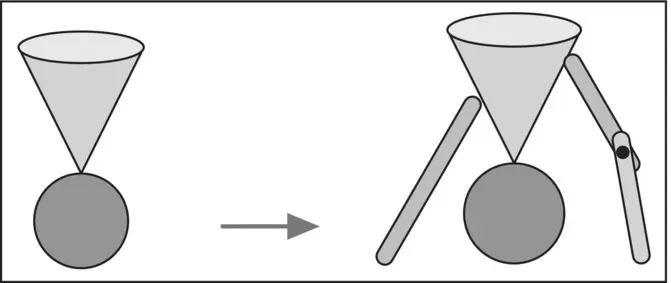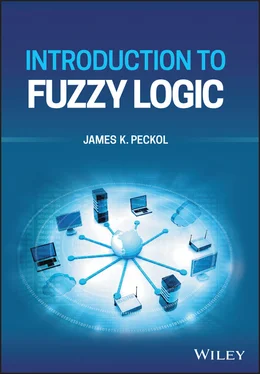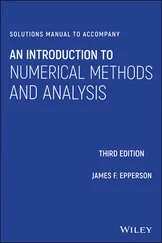James K. Peckol - Introduction to Fuzzy Logic
Здесь есть возможность читать онлайн «James K. Peckol - Introduction to Fuzzy Logic» — ознакомительный отрывок электронной книги совершенно бесплатно, а после прочтения отрывка купить полную версию. В некоторых случаях можно слушать аудио, скачать через торрент в формате fb2 и присутствует краткое содержание. Жанр: unrecognised, на английском языке. Описание произведения, (предисловие) а так же отзывы посетителей доступны на портале библиотеки ЛибКат.
- Название:Introduction to Fuzzy Logic
- Автор:
- Жанр:
- Год:неизвестен
- ISBN:нет данных
- Рейтинг книги:4 / 5. Голосов: 1
-
Избранное:Добавить в избранное
- Отзывы:
-
Ваша оценка:
- 80
- 1
- 2
- 3
- 4
- 5
Introduction to Fuzzy Logic: краткое содержание, описание и аннотация
Предлагаем к чтению аннотацию, описание, краткое содержание или предисловие (зависит от того, что написал сам автор книги «Introduction to Fuzzy Logic»). Если вы не нашли необходимую информацию о книге — напишите в комментариях, мы постараемся отыскать её.
Learn more about the history, foundations, and applications of fuzzy logic in this comprehensive resource by an academic leader Introduction to Fuzzy Logic
Introduction to Fuzzy Logic
Introduction to Fuzzy Logic
Introduction to Fuzzy Logic — читать онлайн ознакомительный отрывок
Ниже представлен текст книги, разбитый по страницам. Система сохранения места последней прочитанной страницы, позволяет с удобством читать онлайн бесплатно книгу «Introduction to Fuzzy Logic», без необходимости каждый раз заново искать на чём Вы остановились. Поставьте закладку, и сможете в любой момент перейти на страницу, на которой закончили чтение.
Интервал:
Закладка:
As a result, fuzzy logic has proven to be a powerful and effective tool for modeling systems with uncertainties in their inputs or outputs or for use when precise models of a system are either unknown or extremely complex.
I.7 Can I Use Fuzzy Logic to Solve All My Design Problems?
Perhaps, however, you should not use fuzzy logic in those systems for which you already have a good or optimal solution using traditional methods. If there is a simple and clearly defined mathematical model for the system, use it. Fuzzy logic, like any other tool, must be used properly and carefully.
Fuzzy logic has been found to give excellent results in several general areas. The most common usage today is in systems for which complete or adequate models are difficult to define or develop and in systems or tasks that use human observations as input, control rules, or decision rules.
The Hitachi's control system for the Sendai subway near Tokyo and Matsushita's one‐button washing machine are very good examples. A fuzzy logic approach also works well in systems that are continuous and complex and that have a nonlinear transfer function or in which vagueness is common.
I.8 What's Wrong with the Tools I'm Using Now?
Nothing. Fuzzy logic does not replace your existing tools; it gives you an additional one. Fuzzy logic simplifies the task of representing and working with vague, imprecise, or ambiguous information often common in human speech, ideas, or reasoning. It provides a means for solving a set of problems that have been difficult or impossible to solve using traditional methods. Consider working examples such as automatic flight control for a helicopter, or the precise management of the freezing of fish in a home freezer.
I.9 Should I Implement My Fuzzy System in Hardware or Software?
Either one. Good tools and solutions are available for hardware and software. However, today fuzzy logic is essentially a “software type” technology and should probably be considered and evaluated that way. This is good news to us as designers. It means that we should be able to take advantage of all that we've learned about developing good software and hardware systems and apply it to developing good fuzzy logic solutions.
As with software, continuous technological improvements will ensure a migration of fuzzy logic into hardware. Hardware solutions may certainly run faster, but software solutions are more flexible and do offer a hedge against the possible unavailability of parts. Such systems, as we'll see, also have the ability to learn. Whichever approach is finally selected, one still needs to go through the rigorous process of analyzing the product under development, making the same trade‐offs we have always made, and thoroughly testing the resulting design and product for safety and reliability.
I.10 Introducing Threshold Logic
As we now move forward, we introduce and explore two tools that build on and extend the knowledge gained from crisp and fuzzy logic. These tools are called threshold logic and perceptrons . Threshold logic builds on and extends the capability of the traditional combinational logic gates. The incorporated features ultimately make important contributions to the foundation of advanced tools called neural networks , machine learning, and artificial intelligence .
I.11 Moving to Perceptron Logic
We move next to a very fascinating device called a perceptron . This device is also known as an artificial neuron . The perceptron incorporates capabilities from both fuzzy logic and threshold logic and includes the capability to learn. Starting with a high‐level model, we introduce the vocabulary describing the elementary components and capabilities of the device. From there, we move to the McCulloch–Pitts (MCP) artificial neuron, which we will examine and then implement a basic model. We also illustrate implementing fundamental classic logic devices using the MCP model.
I.12 Testing and Debugging
Once we design and build the hardware and firmware for our system, we move to confirming that it works. To support that process from its beginning, we include two appendices that introduce and present how to write solid Requirements and Design Specifications and to outline the fundamental functionality of your design.
I.13 Summary
We introduced the design and development tools called fuzzy logic, threshold logic, and perceptrons and presented a brief high‐level overview of how fuzzy logic compares with the traditional crisp logic and other possible sources of additional information. The topics discussed are contributing to and pushing the limits of several very interesting technologies.
The full book can provide a powerful tool for the student in the traditional undergraduate electrical engineering, computer engineering, or computing science programs as well as the practicing engineer.
Our goal in introducing the technologies and designing systems based upon those technologies covered in the book is to help people solve today's and tomorrow's interesting and challenging problems. We stress very strongly that the traditional design, test processes, and formal methods (particularly including safety and reliability) do not go away; rather they become more relevant as we move to ever‐increasingly complex systems.
As you work through the book, try to remember a couple of things. People use our products – our designs can affect people's lives. Once again, always do your best to make your designs as safe and as reliable as you can for each application. Remember too that the cost of a product isn't limited to the cost of the parts that make it up. We also have to consider costs of building, selling, supporting, and adding new features to your design.
Remember that good system designers and designs proceed using a minimum of six steps:
✓ Requirements Definition
✓ System Specification
✓ Functional Design
✓ Architectural Design
✓ Prototyping
✓ Testing
Finally, remember that our responsibility for a design doesn't end with design release. Also, we stress that a good, solid, and reliable design always begins with a firm foundation. Without that, everything we add later is fragile. Good luck, have fun, and learn from each design.

Review Questions
Fuzzy Logic
1 I.1 What is fuzzy logic and is it a new technology?
2 I.2 What are the differences between crisp or classic logic and fuzzy logic?
3 I.3 Can you site several applications where fuzzy logic is used?
4 I.4 What are some of the advantages of fuzzy logic?
5 I.5 What is a linguistic hedge and where would it be used?
Threshold Logic
1 I.6 What is threshold logic?
2 I.7 Where might threshold logic be used?
3 I.8 Can you explain what these applications are?
Perceptrons
1 I.9 What are perceptrons?
2 I.10 It is claimed that a perceptron can learn. Can you propose what it should be learning and how that might be done?
Thought Questions
1 I.1 Give two examples of systems that would benefit from fuzzy logic over crisp logic.
2 I.2 What are some of the more difficult problems that a fuzzy system might confront?
3 I.3 What criteria might you use to set values for a threshold in a threshold logic circuit?
Читать дальшеИнтервал:
Закладка:
Похожие книги на «Introduction to Fuzzy Logic»
Представляем Вашему вниманию похожие книги на «Introduction to Fuzzy Logic» списком для выбора. Мы отобрали схожую по названию и смыслу литературу в надежде предоставить читателям больше вариантов отыскать новые, интересные, ещё непрочитанные произведения.
Обсуждение, отзывы о книге «Introduction to Fuzzy Logic» и просто собственные мнения читателей. Оставьте ваши комментарии, напишите, что Вы думаете о произведении, его смысле или главных героях. Укажите что конкретно понравилось, а что нет, и почему Вы так считаете.












